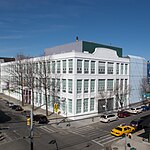Trinity Lutheran Church (Queens)
1926 establishments in New York City20th-century Lutheran churches in the United StatesAstoria, QueensChurches completed in 1926Churches in Queens, New York ... and 6 more
Gothic Revival church buildings in New York CityLutheran churches in New York CityNew York City church stubsProperties of religious function on the National Register of Historic Places in Queens, New YorkQueens, New York building and structure stubsQueens County, New York Registered Historic Place stubs

Trinity Lutheran Church is a historic Lutheran church at 31-18 37th Street in Astoria, Queens, New York. It was designed by John William Cresswell Corbusier and overseen by architect George W. Conable (1866–1933). It was built in 1926 and is a one-story Collegiate Gothic style building. It is constructed of brick faced with coursed rubble aplite trimmed in cast stone. The front elevation features a recessed entry with a large window above, framed by two spires with ornate turrets. The interior is in a Gothic plan of nave and transepts.It was listed on the National Register of Historic Places in 2008.
Excerpt from the Wikipedia article Trinity Lutheran Church (Queens) (License: CC BY-SA 3.0, Authors, Images).Trinity Lutheran Church (Queens)
37th Street, New York Queens
Geographical coordinates (GPS) Address External links Nearby Places Show on map
Geographical coordinates (GPS)
| Latitude | Longitude |
|---|---|
| N 40.761752777778 ° | E -73.919222222222 ° |
Address
Trinity Lutheran Church
37th Street
11101 New York, Queens
New York, United States
Open on Google Maps







